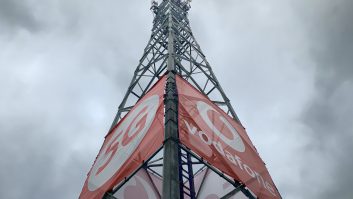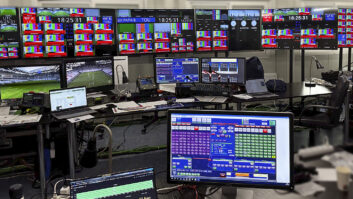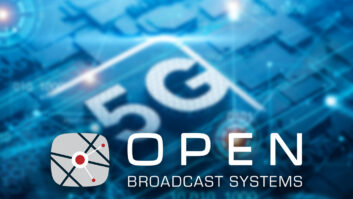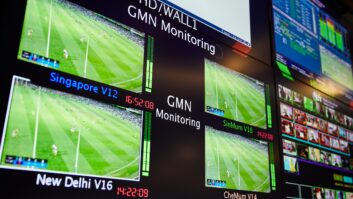The arrival of 5G marks a sea-change for the broadcast world, especially for companies like NEP that serve the live and remote production industries. “It’s already here, and NEP is already using it,” says Donald Begg, director of technology, Major Events, NEP UK. “5G offers the ability to have download speeds measurable in gigabits per second; however, in the real world, speeds between 100Mbps and 200Mbps is a more likely offering. Latency should be significantly lower when compared to 4G, and the number of devices able to be connected in, for example, a football stadium, is 500 times greater than 4G.”
EE has rolled out this new generation of cellular technology in six cities so far, though performance is far from guaranteed. “5G requires more sites, towers and infrastructure which will result in lower performance as you travel through an area,” notes Dan Grainge, president, US Specialty Capture – Fletcher, NEP. “It is far less likely to travel through a city in the next few years and receive a consistent 5G signal. It will more likely bounce back and forth from 5G to LTE. In a TV truck environment that is parked in a well-covered 5G location it should be possible to assume better connectivity and speeds.”
For video the viewing experience will be improved by 5G, as Begg explains: “More bandwidth will allow for an enhanced viewing experience. Broadcasters and OTT operators will be able to enhance the coverage they offer, with more angles, slo-mo replays, stats, etc. all being possible.”
“In production, greater camera mobility will allow creation of richer content,” agrees Dave Meynell, MD, NEP Connect UK. “In broadcast greater bandwidth enables higher resolutions and paves the way for a more immersive, interactive viewing experience.”
The flexibility of camera placement opens several opportunities for remote production. “In theory 5G allows you to use radio frequency (RF) cameras without requiring receive infrastructure, and just managing the spectrum required,” says Peter Larsson, president, Broadcast Sports International, NEP US. “There will be numerous shows where this will be applicable, some shows such as golf and auto racing sometimes will be in areas with limited 5G coverage and may be difficult.”
Grainge sees such benefits in cases where strong 5G infrastructure exists, but does not believe the technology will impact the company’s current RF links. “By nature of 5G with its high frequency requiring many receive sites and high infrastructure costs, it is less likely it would be available in those challenging locations,” he comments. “By the time 5G has a large reliable network our current RF links will have changed. Overall spectrum availability is a much bigger issue to our current RF inventory than 5G.”
“I believe 5G will have an opening for onboard systems on bikes and cars and other items that cannot have a cable attached,” adds Casper Choffat, vice president, Global Media Solutions, NEP. “When it is a privately managed 5G network, this would be suitable for broadcasting in higher-tier events as well. Due to a larger bandwidth, the quality of the video transmission is much higher than the current 4G systems, and this allows for lower latency, high bandwidth, high-quality wireless video transmission on a large/wide site.”
Over the next 10 years, the company plans to invest in the new technology, as Grainge expects 5G to be deployed “in some capacity” on all remote productions by 2030. Begg concurs: “I think 5G will feature in production, and we will undoubtedly see some lower-tier events being covered with 5G. I do, however, think that major sporting events will want the reliability, guaranteed bandwidth, and latency that diverse fibre connections offer. 5G will certainly feature in the disaster recovery offerings.”
Begg predicts that news broadcasters will make more extensive use of the fifth-generation technology than live sports, and will be a “great enhancement” for providing backup paths. Meynell adds: “I can see 5G being a good DR/backup option in the short term and for locations where fibre is problematic either due to short notice eg. breaking news, or due to digs being required. If the telcos make the economics viable vs fibre I think we’ll see a faster takeup of 5G as an option.”
“As we see more about how 5G rolls out and the deployment of slicing, new venues may well have a 5G element to their connectivity,” Meynell continues. “I think 5G will also play a role in disaster recovery and backup options for remote productions and for situations where fibre rollouts are perhaps delayed. It’s another tool in the kitbag for providing flawless service.”
Network slicing allows the 5G network to be split into multiple virtual networks, Begg explains: “These networks can have guaranteed levels of service applied to them. This would greatly enhance the link reliability and should allow broadcasters to cover events using 5G connected cameras. I do think that network slicing is likely to be expensive and may be out of reach for a lot of productions.”
“It is interesting to read the different perspectives regarding the network slicing and reliability of 5G,” adds Grainge. “It seems clear due to different government regulations and business models that this will vary widely as 5G gets rolled out around the world. This variance will have an effect on the implementation and adoption in our industry. Because we will be benefiting from a consumer-driven product its benefit to our industry will be inconsistent for several years.”
Though still something of an unknown quantity, 5G is poised to make a sizeable impact, whichever way you slice it.







